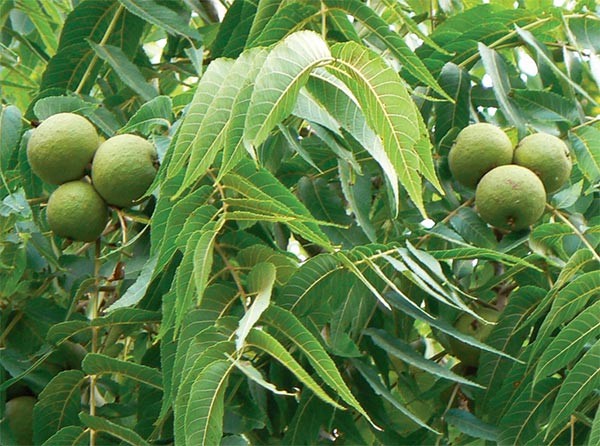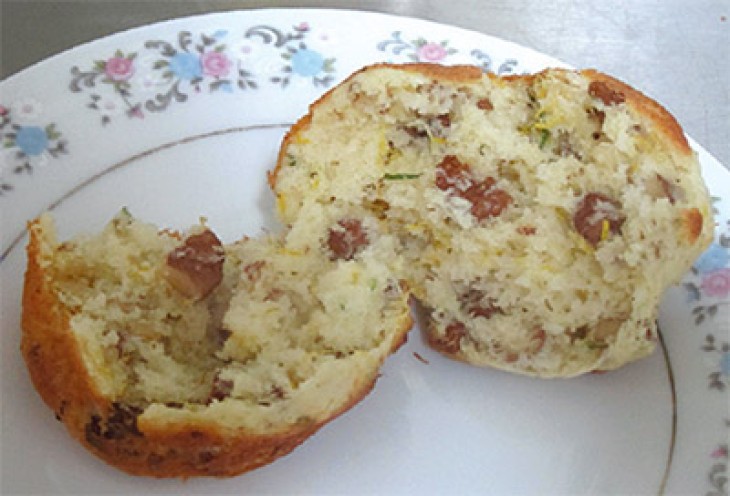Standing in a supermarket amidst frozen dinners, bakery items, and cereals, it’s easy to forget the work involved in preparing food. While it is wonderful to be relieved of so much work, this luxury has its cost. Food preparation has always been the thing that brings us together to enjoy one of the great pleasures of human life – the company of family and friends. Preparing wild black walnuts (Juglans nigra) is one of my family’s favorite excuses to do just that.
The black walnut is not native to much of the Northeast but is widely naturalized and often found in the yards of old farmhouses. The nuts from these yard trees are easier to gather than those that fall in the forest, so hunting for black walnuts provides a great reason to meet new neighbors. In October, ask for permission to gather the fallen nuts and your neighbors may thank you for saving them the chore, as the hard-shelled walnuts are a nuisance to lawn mowers. Bring thick gloves and some five-gallon buckets; on good years, gallons of nuts can be gathered in a matter of minutes.
The next step is to remove the sticky, green husk from around the nut – it’s the only part of the process that I tend to do alone. I let the husks rot outside for several weeks in large milk crates; then I work them off with my hands under a hose. Because the husks contain a dark ink, I don clothes that I don’t mind getting stained and long rubber gloves. (Soak the husks in water and you can make a purplish-black dye.) Then I let the nuts dry for at least a month.
The black walnut can be an intimidating nut to crack, so teamwork is essential. Enthusiasts recommend all kinds of methods, from expensive specialty nutcrackers to running the nuts over with your car. But in our household, we invite friends over and set up a little assembly line. First, someone with a sledgehammer breaks the nut in two over a rock – being careful only to crack and not to shatter the shell. They pass the broken nuts on to someone armed with a smaller hammer and a pair of wire cutters, whose job it is to break or cut away enough of the shell to expose the nutmeats. At the end are folks with nut picks who remove the nutmeat and discard the shells. We do everything over a tarp so that the broken nutshells are not left around to cut any bare feet.
Most people know how to cook with and eat the common English walnut, and black walnuts can be used in the same ways. But the flavor of the black walnut is far superior, with an almost fruity aroma. In our house, most of the walnuts are eaten before they ever make it into a recipe.
The time it takes to procure a quart or two of wild black walnuts makes me grateful for the easy abundance of prepared foods available in the supermarket. But I am also grateful for the satisfaction of being able to share a meal won through my own work and for the chance to experience the fellowship that has bound our human family together from its earliest days as people sang, joked, shared secrets, and fell in love over the happy chore of turning nuts into food.
Dandelion and Black Walnut Muffins
2 cups flour
1 tsp salt
4 tsp baking powder
1/2 cup maple syrup
1 cup yogurt – plain or vanilla
1 egg
1/4 cup melted butter or oil
1-2 cups dandelion petals, separated from the green bracts
1 cup black walnuts
Preheat oven to 425°. Grease muffin tins. Mix flour, salt, and baking powder in large mixing bowl. Add maple syrup, egg, and yogurt. Mix well. Add butter or oil. Mix. Add dandelion petals and black walnuts. Mix well. Pour into greased muffin tins and bake 10 to 14 minutes until a toothpick comes out clean. (Makes one dozen.)




Discussion *